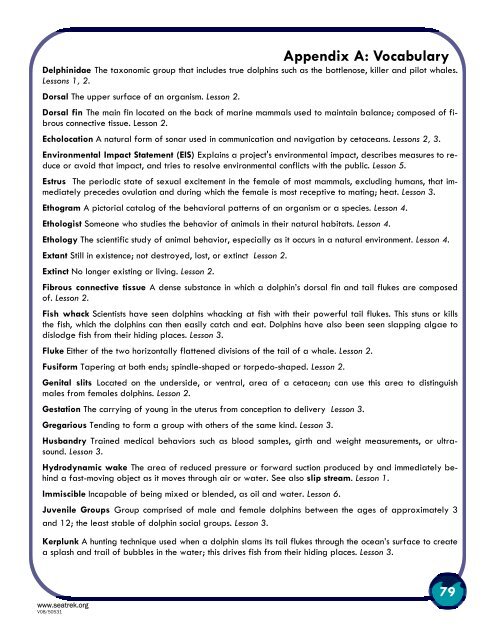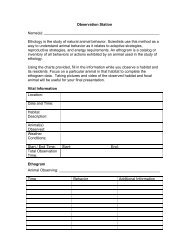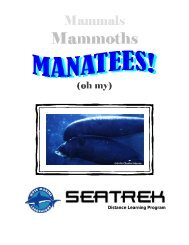LESSON 2 - SeaTrek Programs
LESSON 2 - SeaTrek Programs
LESSON 2 - SeaTrek Programs
You also want an ePaper? Increase the reach of your titles
YUMPU automatically turns print PDFs into web optimized ePapers that Google loves.
Appendix A: Vocabulary<br />
Delphinidae The taxonomic group that includes true dolphins such as the bottlenose, killer and pilot whales.<br />
Lessons 1, 2.<br />
Dorsal The upper surface of an organism. Lesson 2.<br />
Dorsal fin The main fin located on the back of marine mammals used to maintain balance; composed of fibrous<br />
connective tissue. Lesson 2.<br />
Echolocation A natural form of sonar used in communication and navigation by cetaceans. Lessons 2, 3.<br />
Environmental Impact Statement (EIS) Explains a project's environmental impact, describes measures to reduce<br />
or avoid that impact, and tries to resolve environmental conflicts with the public. Lesson 5.<br />
Estrus The periodic state of sexual excitement in the female of most mammals, excluding humans, that immediately<br />
precedes ovulation and during which the female is most receptive to mating; heat. Lesson 3.<br />
Ethogram A pictorial catalog of the behavioral patterns of an organism or a species. Lesson 4.<br />
Ethologist Someone who studies the behavior of animals in their natural habitats. Lesson 4.<br />
Ethology The scientific study of animal behavior, especially as it occurs in a natural environment. Lesson 4.<br />
Extant Still in existence; not destroyed, lost, or extinct Lesson 2.<br />
Extinct No longer existing or living. Lesson 2.<br />
Fibrous connective tissue A dense substance in which a dolphin’s dorsal fin and tail flukes are composed<br />
of. Lesson 2.<br />
Fish whack Scientists have seen dolphins whacking at fish with their powerful tail flukes. This stuns or kills<br />
the fish, which the dolphins can then easily catch and eat. Dolphins have also been seen slapping algae to<br />
dislodge fish from their hiding places. Lesson 3.<br />
Fluke Either of the two horizontally flattened divisions of the tail of a whale. Lesson 2.<br />
Fusiform Tapering at both ends; spindle-shaped or torpedo-shaped. Lesson 2.<br />
Genital slits Located on the underside, or ventral, area of a cetacean; can use this area to distinguish<br />
males from females dolphins. Lesson 2.<br />
Gestation The carrying of young in the uterus from conception to delivery Lesson 3.<br />
Gregarious Tending to form a group with others of the same kind. Lesson 3.<br />
Husbandry Trained medical behaviors such as blood samples, girth and weight measurements, or ultrasound.<br />
Lesson 3.<br />
Hydrodynamic wake The area of reduced pressure or forward suction produced by and immediately behind<br />
a fast-moving object as it moves through air or water. See also slip stream. Lesson 1.<br />
Immiscible Incapable of being mixed or blended, as oil and water. Lesson 6.<br />
Juvenile Groups Group comprised of male and female dolphins between the ages of approximately 3<br />
and 12; the least stable of dolphin social groups. Lesson 3.<br />
Kerplunk A hunting technique used when a dolphin slams its tail flukes through the ocean’s surface to create<br />
a splash and trail of bubbles in the water; this drives fish from their hiding places. Lesson 3.<br />
www.seatrek.org<br />
V08/50531<br />
79





